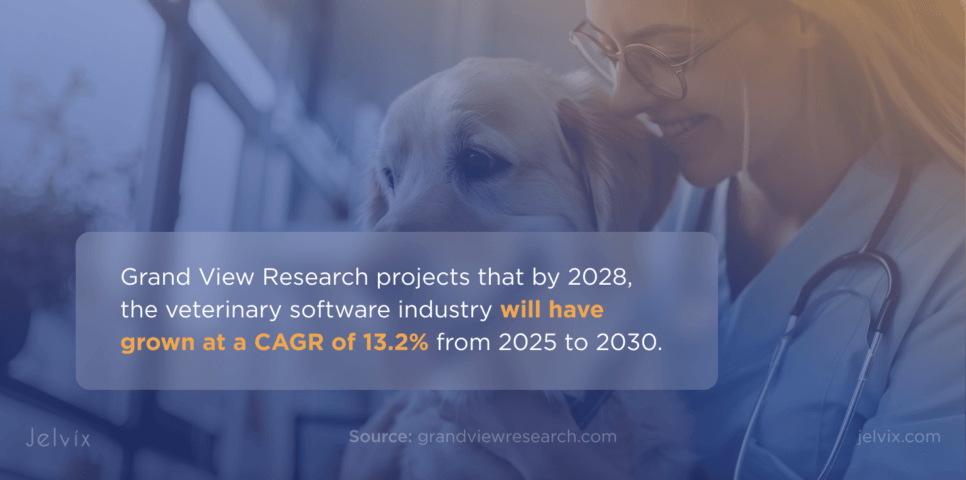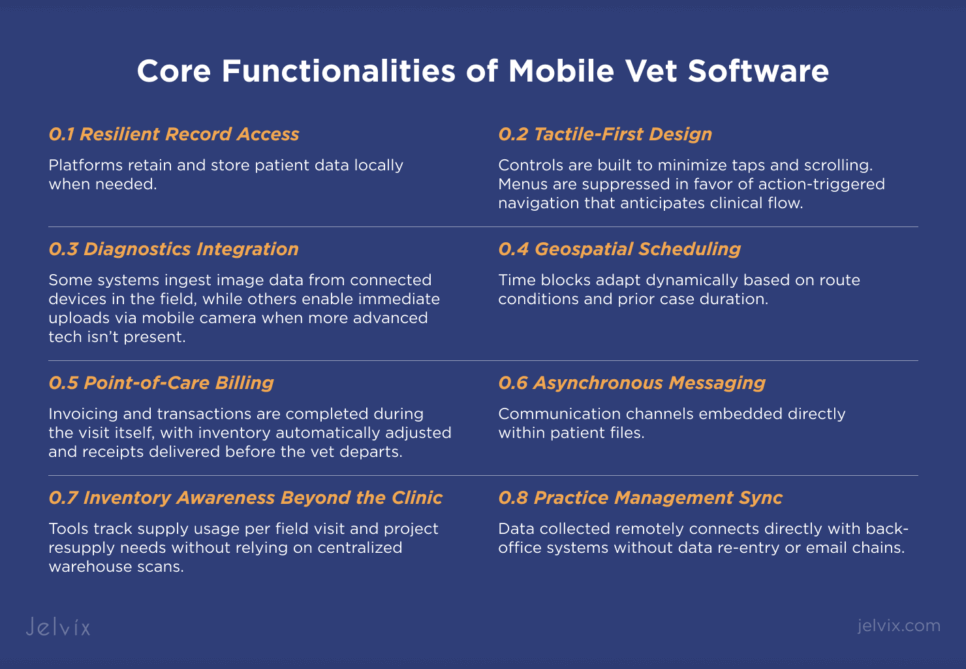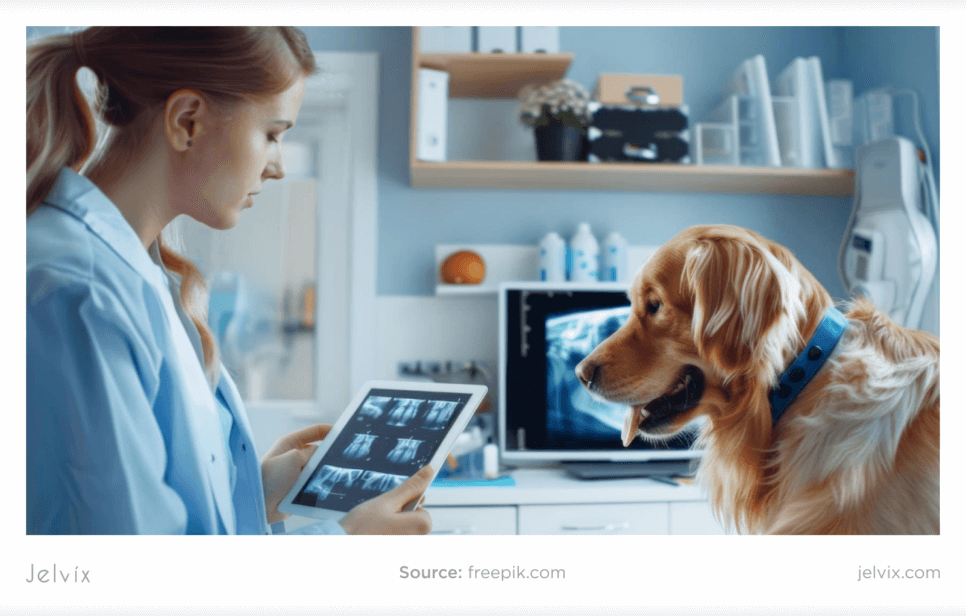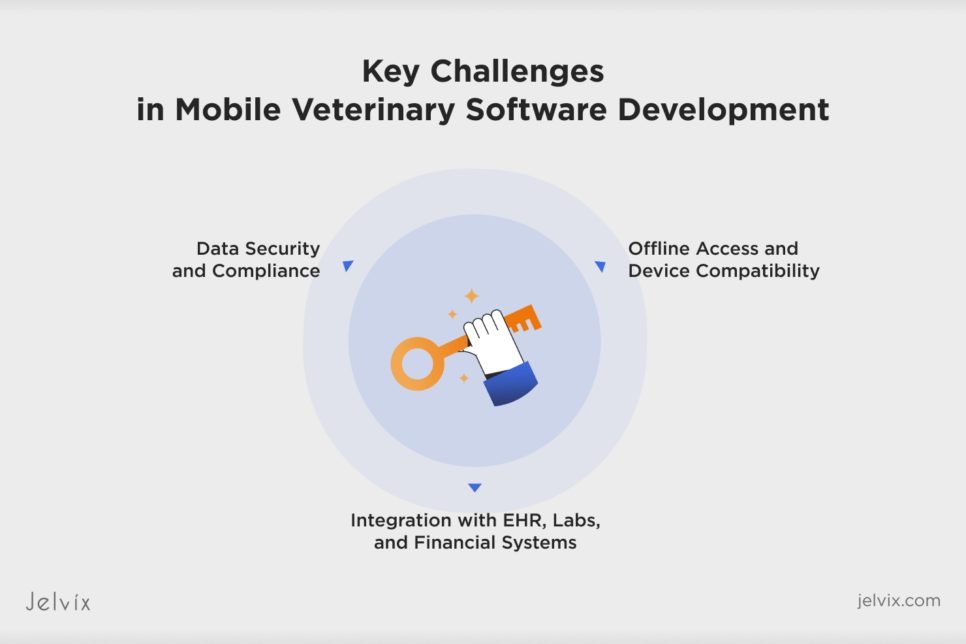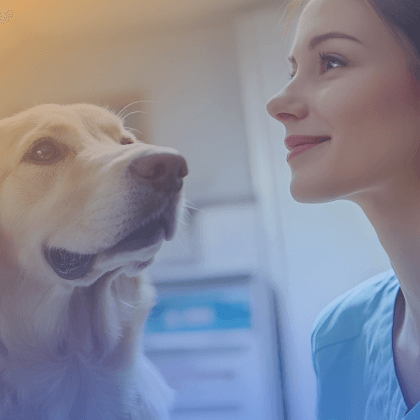Veterinary care is going through a calibration. Clinics are increasingly defined by flexible, data-centric infrastructure—much of which is intended for mobility—instead of isolated systems and analog routines. Beyond the margins of practice administration, mobile veterinary software is becoming the operational core, allowing veterinarians to coordinate diagnostics, client communication, and inventory tracking without ever sitting at a desk.
Grand View Research projects that by 2028, the veterinary software industry will have grown at a CAGR of 13.2% from 2025 to 2030. Trend-chasing isn’t what yields this. The figures show a realignment in how services are delivered: scattered care models, greater caseloads, and digital-first pet owners are redefining clinical expectations. Over 60% of clinics now rely on mobile platforms for at least part of their daily operations, according to a 2024 American Veterinary Medical Association poll—and that number is rising.
From fragmented apps, the next two years will see a movement toward cohesive ecosystems. Not exactly larger, but most definitely more compatible. Mobile platforms will be assessed more on how successfully they compress time, remove redundancy, and surface pertinent data at the point of need than on what features they provide.
That’s what we’ll unpack next: the structural shifts underway and the real-world applications of mobile veterinary software in 2025 and beyond.
What Is Mobile Veterinary Software?
Mobile vet software refers to digital tools that support tasks for veterinarians employed outside a fixed clinic location. Its design philosophy emphasizes immediacy, context awareness, and adaptation under real-world field conditions—not a mobile version of desktop software.
Unlike conventional systems designed for front-desk processes, these mobile platforms are shaped by limitations. Interfaces have to react quickly with minimum intervention. From updating patient notes to initiating payment, every procedure must be feasible mid-route or immediately following a consultation without involving a return to the base system.
Workflow design decides whether a process moves forward on schedule or is delayed owing to insufficient diagnostic data, payment friction, or missing records.
Therefore, a mobile veterinarian doesn’t have the luxury of switching between several systems or depending on hardwired servers. This change in use case calls for a completely different architecture.
Core Functionalities of Mobile Vet Software
- Resilient Record Access: Platforms retain and store patient data locally when needed.
- Tactile-First Design: Controls are built to minimize taps and scrolling. Menus are suppressed in favor of action-triggered navigation that anticipates clinical flow.
- Diagnostics Integration: Some systems ingest image data from connected devices in the field, while others enable immediate uploads via mobile camera when more advanced tech isn’t present.
- Geospatial Scheduling: Time blocks adapt dynamically based on route conditions and prior case duration.
- Point-of-Care Billing: Invoicing and transactions are completed during the visit itself, with inventory automatically adjusted and receipts delivered before the vet departs.
- Asynchronous Messaging: Communication channels embedded directly within patient files.
- Inventory Awareness Beyond the Clinic: Tools track supply usage per field visit and project resupply needs without relying on centralized warehouse scans.
- Practice Management Sync: Data collected remotely connects directly with back-office systems without data re-entry or email chains.
There’s no single blueprint for vet software designed for mobile workflows. Certain tools serve full-time mobile veterinary operations—those who work only in rural or home-care settings.
Others are hybrids, extending current veterinary practice management tools into cloud-hosted portals, allowing remote access, offline capability, or appointment handling in transit. Specialty platforms also exist. For example, mobile-first apps dedicated just to telemedicine, inventory control, or point-of-care diagnostics.
Answering the question “what is a mobile vet?” no longer stops at “a vet who travels.” It now implies a digital ecosystem built for responsiveness and immediacy between locations, and the software needs to reflect that reality without compromise.
Benefits of Mobile Veterinary Software
When the tools lag behind the treatment, clinical momentum stops. In mobile practice, timing is not flexible; what has to be done must be done immediately, usually without support workers or complete system access. Mobile veterinary software fills in for that lack. It gives structure where none exists and substitutes immediacy for delay.
Little tweaks—tracking on-site, looking over patient records en route, fixing billing before the next visit—have a big impact on how the day turns out. They stop later on the pile-on events. Clinics go forward without accumulating administrative residue, without catching up after hours, or assigning cleanup to someone else.
Though they may not see the infrastructure, clients experience its impact. Perfect communication results in payments not stalling and care instructions arriving when expected, which in turn helps to build trust. Not only does satisfaction weigh in, but also adherence, follow-up, and the possibility of seeing the client under less intense conditions.
These systems are not meant to run alone. Mobile data shapes the main veterinary practice management software as it enters it. Notes remain legible to other staff. Inventory counts adjust automatically. Field appointments match the central calendar, without the team later filling in blanks.
Aligning mobile platforms with core veterinary practice software makes all the difference between coping and running at full capacity in systems where time is the one asset that cannot be reordered or refilled.
Key Trends in Mobile Veterinary Software 2025–2026
Veterinary care sets distinct demands that software now has to meet. Over the next two years, vet practice software will evolve by responding to clear, structural needs from practitioners in motion.
AI Is No Longer Auxiliary
AI is increasingly integrated into veterinary diagnostics, enhancing accuracy and efficiency. For instance, AI algorithms are being applied to diagnostic imaging, such as X-rays and CT scans, to detect fractures, tumors, or inflammatory diseases with high precision, aiding veterinarians in making timely diagnoses. Currently in use in cattle herd monitoring systems, this edge-AI architecture is also starting to find use in companion animal medicine.
The trend in 2025 is leaning toward condition-specific machine learning models trained inside vertical systems. Newer engines embedded within vet practice solutions learn from organized clinical inputs, breed-specific pathology, and localized case patterns, unlike general-purpose AI technologies. That implies lightweight inference layers run locally, with model updates synchronized regularly, providing diagnostic support for mobile deployments free from full cloud dependency.
Learn how we developed an AI-powered veterinary solution in our case study.
Increased Demand for Telehealth and Remote Care
According to the Mordor Intelligence, the veterinary telemedicine market is experiencing significant growth, projected to reach USD 282.13 million in 2025 and USD 673.25 million by 2030. This surge reflects the increasing demand for remote veterinary services, driven by the need for accessible and convenient care options.
These days, teleconsultation modules tie into SOAP notes, billing records, and prescription authority. Certain veterinary clinic software uses conditional scripting: if a patient completes an online intake with flagged symptoms, the app creates a temporary treatment plan and prep list automatically for the attending DVM. Mobile systems without that scaffolding just provide video calls; they do not provide telehealth.
Mobile-First Design and User-Centric Interfaces
The best veterinary mobile apps don’t rely on user-driven navigation to finish a process anymore. Rather, actions set off context-aware modules. Choosing a patient with a chronic disease, for instance, might immediately access recent lab data, pull dosing histories, and highlight compliance issues—all before the veterinarian enters anything. This is reactive architecture made possible by embedded protocols and prefetching logic, not just a UI polish. Predictive touchpoints are taking the place of static menus.
Interoperability with Wearables and IoT in Animal Health
Wearable and implant data won’t be imported manually post-visit in 2026. Already supporting continuous sync from pet biosensors over secured protocols, certain digital veterinary tools also provide edge filtering to eliminate false readings. Configured by species or diagnosis, data relevance filters are beginning to control what shows on mobile dashboards.
This means not just more data but also cleaner, more clinically valuable data arriving at the vet in real time, even midway through a visit.
Emphasis on Cybersecurity and Data Privacy
System architecture is being rebuilt around limitations as mobile software manages sensitive medical and financial data in less-controlled environments. Veterinary apps are starting to follow zero-trust concepts, including per-device identity mapping, tokenized session control, and client-side encryption.
Platforms where security is embedded into the data model itself are already displacing those that view security as a module. This will be regulatory rather than discretionary in areas where veterinarian records link to controlled medication logs or insurance claims.
In short, the future isn’t defined by feature lists—it’s shaped by how well platforms handle complexity without forcing that complexity onto the user.
Key Challenges in Mobile Veterinary Software Development
Data Security and Compliance
Although HIPAA does not extend to animal health records, veterinarian operations in the United States must follow different state data protection regulations, with 35 states having statutes addressing patient record confidentiality for pets and livestock.
Veterinary clinics in the European Union are obliged by the General Data Protection Regulation (GDPR) to use strict data protection policies, including acquiring appropriate client permission and proving compliance with data processing activities.
Data security must be given top priority in veterinary offices if they want to keep customer confidence and evade regulatory fines. Essential is putting in place strong cybersecurity rules like regular data backups, secure data storage, and strong passwords.
Offline Access and Device Compatibility
More is done by a strong offline system than just storing screen info. It has to enable complete CRUD operations—create, read, update, and delete—while disconnected. Many systems use client-side persistence layers—based on technologies like IndexedDB (for browser-based PWAs), SQLite (for Android/iOS native apps), or Realm DB for reactive sync capabilities—to do this properly.
These local stores queue updates in transactional batches using timestamps and unique identifiers, facilitating conflict resolution upon reconnection.
For instance, the system must intelligibly reconcile changes made by two team members updating the same patient record from separate sites using different devices. Often driven by data sensitivity (e.g., clinical diagnosis may supersede scheduling notes), strategies range from last-write-wins to more advanced merging techniques.
Delta sync—transmitting only modified fields instead of whole records—is used increasingly in systems designed for veterinary contexts to save bandwidth during resynchronization.
Compatibility between devices adds another level of difficulty. Veterinarians might mix tablets, phones, and shared workstations; thus, the program needs to be platform-agnostic. This usually means creating centralized authentication-based Flutter, React Native, or native + web hybrid stacks. Layout responsiveness also affects usability while doing tasks like medication calculations, form filling, or radiograph evaluation under time limits.
These technical layers—local-first design, conflict-aware sync, background queuing, and input-safe UI scaling—have to be ingrained from the outset if mobile-first veterinary clinic software is to really run as field infrastructure. Offline access is a structural need that determines whether or not care may proceed without interruption.
Integration with EHR, Labs, and Financial Systems
Operational continuity depends on seamless connection between mobile veterinary platforms and third-party systems, including invoicing software, diagnostic labs, and Electronic Health Records (EHR). Still, this connectivity goes much beyond configuring data streams. It entails converting between different schemas, standardizing dissimilar field values, and ensuring transactional consistency between systems not intended for communication.
Modern veterinary clinic systems have to be able to enable bi-directional data flow over proprietary APIs, HL7, FHIR, or other standards when none exist. For test orders and results, lab systems—for example—often expose XML or HL7 v2 messages.
EHRs might use OAuth 2.0 or JWT tokens to impose rigorous authentication layers. Usually, for payment events, financial systems require PCI-DSS-compliant communication routes, so the veterinary application must split and tokenize financial transactions inside another, safe layer.
Constraints particular to mobile devices complicate this even more. A mid-sync breakdown in network connectivity runs the danger of partial updates. Often using optimistic concurrency control and queuing mechanisms that retry messages intelligibly, developers help to prevent corrupt records. To ensure integrity while synchronizing records gathered offline, good mobile vet practice software may additionally contain audit trails and checksum validation.
Underneath the surface, what might seem to be a “connected ecosystem” is a closely coordinated interchange of serialized data, access control tokens, event handlers, and conflict resolution logic, without which the practice runs the danger of duplication, data loss, or compliance violations.
Stages of Developing Veterinary Mobile Software
Market Research and Requirement Gathering
The starting point isn’t wireframes—it’s domain specificity. Veterinary mobile platforms have to account for species diversity, multi-location scheduling, drug log regulations, and integration with lab and billing ecosystems. Surface-level market research won’t capture that.
Instead, development teams conduct stakeholder interviews with DVMs, vet techs, and practice managers to isolate friction points that generic mobile software can’t address.
This often results in a workflow decomposition model, where developers map each step of a field consult, from intake to invoicing, to technical operations. These models clarify not just what to build, but what to exclude. For example, a rural mobile vet handling large animals will need multi-patient batch scheduling and offline drug inventory tracking.
A mobile surgery provider in an urban area might prioritize rapid imaging integration over in-depth case history retrieval.
UX/UI Design Tailored for Veterinarians
Technical choices here matter. For native apps, layout components often rely on conditional rendering frameworks that detect use context (e.g., tablet vs. phone, left-hand vs. right-hand use) and reorganize the UI accordingly. Haptics and offline-safe form validation need to work in tandem.
Forms for SOAP entries, diagnostics, and billing are designed to support incremental autosave, so a field update mid-sentence isn’t lost if the app is backgrounded. For web-based platforms, PWA architecture (Progressive Web Apps) with service workers enables local caching, instant reloads, and queue-based writeback once online.
Core Development and API Integrations
Backend architecture typically starts with a multi-tenant SaaS model, where each clinic’s data is segmented logically, often using row-level security at the database layer. Frontends are frequently built in React Native or Flutter to maximize cross-platform consistency while retaining near-native performance.
The real complexity lies in interoperability. Veterinary software often needs to communicate with external systems—labs (Antech, IDEXX), payment processors, controlled substance registries, insurance claim handlers, and practice management platforms like Cornerstone or AVImark. This requires supporting RESTful or GraphQL APIs, handling legacy HL7 or XML lab data formats, and maintaining ETL pipelines to clean, normalize, and sync data.
Real-time diagnostics from wearables or connected devices introduce event-driven data. Here, WebSocket-based messaging layers or MQTT brokers are often used to handle telemetry, especially when latency matters or when devices push frequent updates.
Compliance Implementation and Testing
Veterinary data is regulated differently across jurisdictions. While HIPAA doesn’t govern animal records, practices still handle personal client data and controlled medication logs, making state-level compliance, GDPR, and PCI-DSS (for payment processing) essential.
Compliance is implemented through encryption-in-transit (TLS 1.3), at-rest data segmentation, and strict RBAC (Role-Based Access Control). Testing includes penetration testing, load testing, and field simulation—verifying behavior during signal loss, multi-user record access, and lab result ingestion from real systems.
Automated test suites run parallel to development using CI/CD pipelines, with emulators simulating device loss, offline queues, and asynchronous record reconciliation. Manual QA in veterinary workflows is also critical: a missed dosage input isn’t a UI bug—it’s a patient safety issue.
Launch, Support, and Iterative Improvements
Initial rollout often begins with a single-site pilot to validate performance in live settings. Data ingestion logs, device sync failures, and error reports are monitored via observability stacks (e.g., Datadog, Sentry, Prometheus).
Support doesn’t end post-launch. Veterinary mobile software evolves based on updates in prescription regulations, device compatibility, and practitioner behavior. A good product roadmap integrates feedback loops directly from in-app telemetry, tracking which features are used, which get abandoned mid-flow, and where bottlenecks form. Iterations are pushed through phased releases, often using feature flagging for incremental rollout without full version updates.
Conclusion
Veterinary teams need better tools that grasp their task; they do not require more software. Mobile platforms will either reduce complexity or become part of the whole system in 2025 and forward. Their development, fit into clinical procedures, and ability to withstand pressure all help to define their differences.
The industry isn’t short on features. What it’s missing is alignment between workflows, devices, data models, and real-world demands. The future generation of veterinary solutions will stand out in this regard: in the way they eliminate steps, manage inconsistency, and maintain information flowing uninterrupted.
Jelvix designs for that level of precision. We work with teams that operate in motion, that need software to keep pace without becoming the bottleneck. If your next move involves building or upgrading mobile veterinary systems, we’re ready to get into the details – let’s talk.
FAQs
Can I integrate mobile veterinary software with my existing systems?
Most modern systems indeed allow interface with EHR systems, diagnostic tools, payment gateways, and pharmacy solutions. Usually, seamless data flow is ensured by custom APIs and middleware.
What do clients appreciate most about mobile veterinary software?
The convenience of mobile apps providing immediate appointment booking, digital access to pet health records, real-time veterinary chat, and payment processing is much valued by pet owners. These features raise the clinic’s general satisfaction, transparency, and communication level.
Which types of veterinary clinics benefit most from mobile software?
Among animal clinics, emergency care providers, and multi-location operations, mobile veterinary software is especially sought after. These offices gain from flexible scheduling, cloud synchronizing, and on-demand access.
Can mobile veterinary software work offline?
Indeed, numerous veterinary apps provide offline capabilities that sync with the cloud as soon as a reliable internet connection is restored. This feature is particularly beneficial for mobile veterinarians or practices located in rural regions.
How much does mobile veterinary software cost?
Pricing depends on features, level of customization, and type of deployment. SaaS platforms usually require monthly fees, whereas custom solutions may entail a one-time development cost along with ongoing support expenses.
Need a qualified team of developers?
Use our top talent pool to get your business to the next level.

